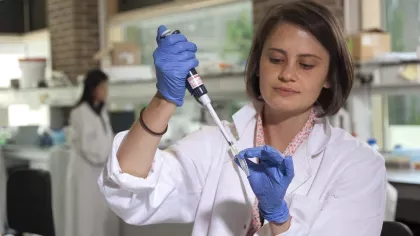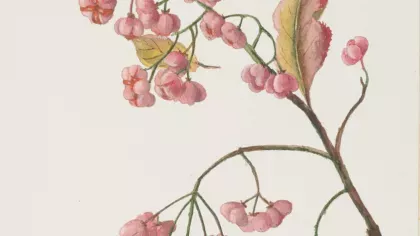Mind the (gender) gap:under 3% of land plant species published by women
A unique and complete dataset created and maintained by Kew scientists over the last 260 years, has revealed a striking difference in the number of new species of plants described by male and female botanists.

Gender representation in science is currently a much discussed and debated issue but most of the recent research has focused on the last 50 years, covering only one or two generations of scientists. Kew's unparalleled data collection lets us throw new light on an entire field, with a complete dataset at our fingertips.
Kew's amazing data resources
Kew holds a huge range of datasets and collections, containing a wealth of information that can be used to answer all manner of questions never conceived of when we started to gather the original records. One such dataset is the enormous International Plant Names Index (IPNI), which succeeded and built upon Index Kewensis, and involves collaborators at the Harvard University Herbaria and the Australian National Herbarium.
Index Kewensis was personally commissioned by Charles Darwin, who left a provision in his will of £250 per annum in order for Kew to 'compile a list of all known plants' (Allan, 1967; Meikle, 1971). Containing all seed plant, fern, and lycophyte names published between 1753 (the 'founding' date for the rigorous and legalistic rules for the valid publication of Linnean botanical nomenclature) and 2013, IPNI also contains records of the botanical author of every plant name published, and the date when the name was published.
Only 12% of all botanical authors are female
By compiling a database of first names and their genders using online resources, we were able to automatically assign gender to a large proportion of the 15,604 botanical authors recorded by IPNI. All authors assigned as female, all authors who published ten or more plant names, and the 500 most prolific male authors were manually checked and researched where necessary to improve the accuracy of assigned names.
Nearly 75% of the author names could be assigned a gender, with the remaining 4,008 names accounting for just 4.37% of new species names published in the later analyses. Most of the names which could not be assigned a gender had no record of first names or initials. There were also many Chinese names which, even after colleagues from the Chinese Academy of Sciences and elsewhere were consulted, were unable to be resolved. Female authors make up just 12.20% of all those who have published plant names since 1753, a strikingly small proportion in a scientific field that has been traditionally considered a relatively acceptable scientific pursuit for women.
Female botanists have named just 3% of new plant species
A complete analysis of all 624,682 species described as new to science between 1753 and 2013, showed that fewer than 3% of all of these species names (17,604) were published by female authors. Even excluding all of the species names published by authors to whom we were unable to assign a gender, we were able to show that 92.81% of all species names were published by male authors.
The first plant species to be published by a female author was Amomum verum Blackw., a wild ginger, the name of which is still in use today, published by Scottish artist and business woman Elizabeth Blackwell (1757). It was not until the 1780s when the second species was published by a woman. Only in the 20th century did female authored names account for more than 1% of all newly published plant species, and female authorship gradually rose throughout the last century until it exceeded 10% in the 1990s. Currently the percentage is just below 12%. Interestingly, over the last twenty years, female authors have on average published 80% of the number of new species published by their male counterparts.
Of the 500 most productive plant name authors, just eight were female — the most productive being Margaret Louisa Bolus (1877-1970), who published 1,494 new species. One is still publishing names today: Missouri Botanical Garden's neotropical Rubiaceae expert Charlotte Taylor, who has published 278 species to date. By contrast the most prolific male author was Augustin Pyramus de Candolle (1778-1841) with 10,222 species names to his credit, and tenth in the male list was Kew's second director, Joseph Dalton Hooker (1817-1911), with 4,558 species names. The top 20 women include two botanists from Kew: Susan (Carter) Holmes who described 149 species, and Diane Bridson who described 113.
Species discovery is far from over
New species continue to be discovered at a remarkable rate, with some 2,000 new plant species described every year (Prance, 2001; Bebber et al., 2010). In an age of increasing extinction risks threatening the survival of species globally, the documentation of otherwise unknown biodiversity is a critical role of scientific organisations such as Kew as institutions, governments, NGOs, and individuals cannot easily protect and conserve what they do not know. Comprehensive data sets such as IPNI allow us to document biodiversity inventory for myriad purposes and, as this study shows, to explore trends in the data over time.
Regardless of gender, researchers such as Charlotte Taylor and botanists all around the world are greatly increasing our knowledge and understanding of the natural world at a time when we most need it.
Original paper: Lindon, H.L., Gardiner, L.M., Brady, A., & Vorontsova, M.S. (2015). Fewer than three percent of land plant species named by women: author gender over 260 years. Taxon. 64(1). DOI: 10.12705/642.4. Available online
References
Allan, M. (1967). The Hookers of Kew. London: Joseph.
Bebber, D.P., Carine, M.A., Wood, J.R., Wortley, A.H., Harris, D.J., Prance, G.T., Davidse, G., Paige, J., Pennington, T.D., Robson, N.K.B. & Scotland, R.W. (2010). Herbaria are a major frontier for species discovery. Proc. Natl. Acad. Sci. U.S.A. 107: 22169–22171. Available online
Blackwell, E. (1737). A Curious Herbal, Vol. 1. London: printed for Samuel Harding. Available online
Meikle, R.D. (1971). The history of the Index Kewensis. Biol. J. Linn. Soc. 3: 295–299. Available online
Prance, G.T. (2001). Discovering the plant world. Taxon 50: 345–359. Available online


